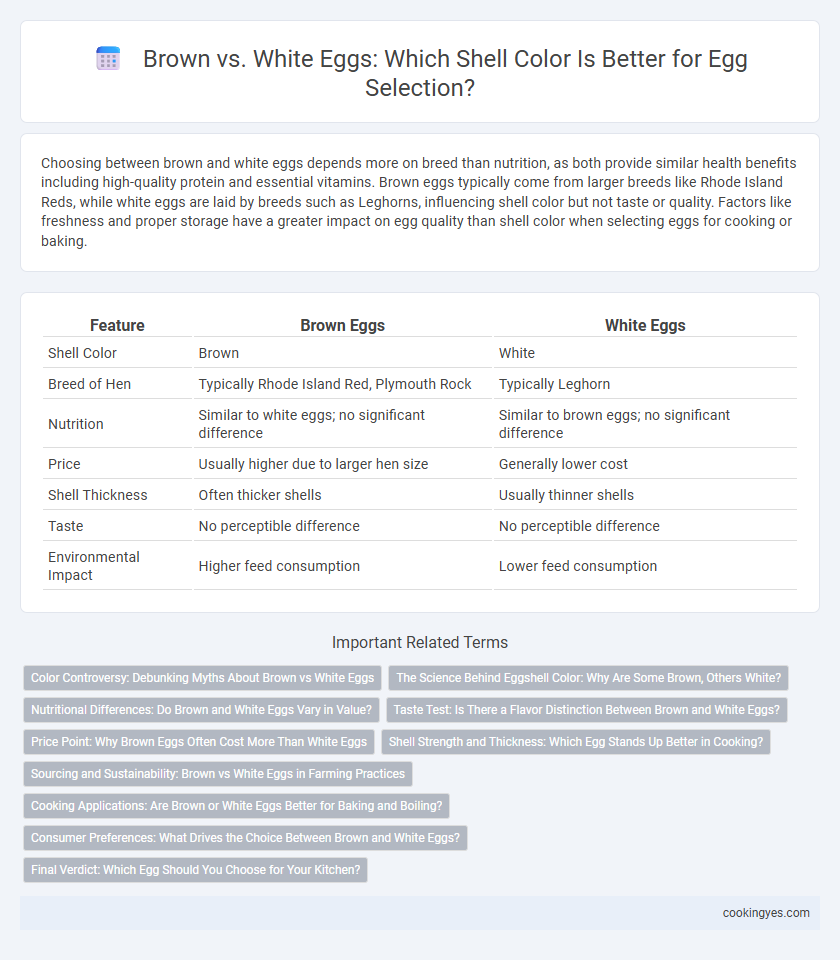Choosing between brown and white eggs depends more on breed than nutrition, as both provide similar health benefits including high-quality protein and essential vitamins. Brown eggs typically come from larger breeds like Rhode Island Reds, while white eggs are laid by breeds such as Leghorns, influencing shell color but not taste or quality. Factors like freshness and proper storage have a greater impact on egg quality than shell color when selecting eggs for cooking or baking.
Table of Comparison
| Feature | Brown Eggs | White Eggs |
|---|---|---|
| Shell Color | Brown | White |
| Breed of Hen | Typically Rhode Island Red, Plymouth Rock | Typically Leghorn |
| Nutrition | Similar to white eggs; no significant difference | Similar to brown eggs; no significant difference |
| Price | Usually higher due to larger hen size | Generally lower cost |
| Shell Thickness | Often thicker shells | Usually thinner shells |
| Taste | No perceptible difference | No perceptible difference |
| Environmental Impact | Higher feed consumption | Lower feed consumption |
Color Controversy: Debunking Myths About Brown vs White Eggs
Eggshell color, determined by the breed of the hen, does not impact nutritional value or taste, debunking myths linking brown eggs to higher quality. White eggs, often produced by White Leghorn chickens, and brown eggs, laid by breeds like Rhode Island Reds, are nutritionally comparable when sourced similarly. Consumer preference for shell color is largely cultural and regional, with price differences driven mainly by production costs rather than quality.
The Science Behind Eggshell Color: Why Are Some Brown, Others White?
Eggshell color is determined by genetics, with brown eggshells resulting from the pigment protoporphyrin deposited during egg formation in hens with specific breeds. White eggs lack this pigment, which is why their shells remain uncolored. The difference in shell color does not affect the egg's nutritional value or flavor but may influence consumer preferences based on regional and market trends.
Nutritional Differences: Do Brown and White Eggs Vary in Value?
Brown and white eggs contain similar nutritional profiles, including protein, vitamins, and minerals, with no significant differences attributable to shell color. The color variation arises from the breed of the hen rather than the egg's nutritional content. Consumers often perceive brown eggs as more natural or healthier, but scientific analysis shows shell color does not impact the egg's nutritional value.
Taste Test: Is There a Flavor Distinction Between Brown and White Eggs?
Brown and white eggs exhibit no significant difference in flavor when subjected to blind taste tests, as taste is primarily influenced by the hen's diet rather than shell color. Studies confirm that the pigment responsible for shell color, protoporphyrin, does not affect egg taste or nutritional value. Consumer preference for brown or white eggs often stems from misconceptions or regional market trends, not inherent flavor distinctions.
Price Point: Why Brown Eggs Often Cost More Than White Eggs
Brown eggs typically cost more than white eggs due to higher production expenses linked to the larger breeds of hens that lay them, which consume more feed and require more space. Consumer perception also drives price differences, as brown eggs are often marketed as more natural or organic, allowing retailers to justify higher price points. Regional demand influences price disparities, with brown eggs favored in certain markets, leading to supply constraints and increased costs.
Shell Strength and Thickness: Which Egg Stands Up Better in Cooking?
Brown eggs generally have thicker and stronger shells compared to white eggs due to differences in breed genetics, which enhances their durability during cooking and handling. The increased shell thickness in brown eggs reduces the risk of cracking and provides better protection in boiling or baking processes. White eggs, while often perceived as more delicate, can still perform well in recipes, but those requiring sturdier shells for intensive cooking benefit from the added strength of brown eggs.
Sourcing and Sustainability: Brown vs White Eggs in Farming Practices
Brown eggs typically come from heritage or traditional breeds that require more feed and resources for production, impacting sustainability in sourcing. White eggs are often sourced from high-efficiency commercial breeds that convert feed more effectively, resulting in a lower environmental footprint. Farmers prioritizing sustainable practices increasingly favor white eggs due to their resource-efficient farming, while brown eggs may be preferred for niche markets emphasizing traditional methods and local sourcing.
Cooking Applications: Are Brown or White Eggs Better for Baking and Boiling?
Brown eggs and white eggs have no significant difference in baking or boiling performance, as shell color does not affect taste or cooking quality. Both brown and white eggs have similar nutritional profiles and functional properties, making them equally suitable for recipes requiring structure, moisture, and binding. Selection for baking and boiling should focus on freshness and size rather than shell color to achieve optimal results.
Consumer Preferences: What Drives the Choice Between Brown and White Eggs?
Consumer preferences for brown versus white eggs often hinge on perceived health benefits, freshness, and taste, despite nutritional content being nearly identical between the two. Brown eggs are frequently associated with natural, organic farming practices and thus attract health-conscious buyers willing to pay premium prices. White eggs, commonly produced in large-scale commercial farms, appeal to consumers prioritizing affordability and availability.
Final Verdict: Which Egg Should You Choose for Your Kitchen?
Brown eggs typically have a slightly thicker shell, which may provide better protection during transport, but both brown and white eggs are nutritionally similar and equally versatile in cooking. Choice depends more on personal preference, availability, and price rather than shell color, as factors like freshness and source impact quality more significantly. For kitchen use, prioritizing farm-fresh or organic eggs regardless of shell color ensures optimal taste and nutritional value.
Brown vs White shell for egg selection Infographic

 cookingyes.com
cookingyes.com